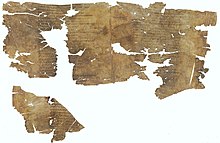Sappho 96

Sappho 96[a] is a poem by the archaic Greek lyric poet Sappho.
Preservation[]
The poem was one of five preserved on a parchment, P. Berol. 9722,[1] found in Egypt. It was originally part of a book created in the sixth century AD.[2] The extant text begins in the middle of a stanza, and it is uncertain how many lines preceded the surviving portion.[3] 37 lines are preserved or partially preserved; they may come from two poems, with the first probably ending at line 20 and the second beginning at the next line of the fragment.[4]
Poem[]
The poem is composed in three-line stanzas based on glyconic cola,[5] made up of a creticus, three glyconics, and a bacchius.[6] Though written over three lines, these stanzas are made up of a single verse without a metrical break, in several cases with words split over two lines.[7] It was likely composed to be sung by a chorus.[8]
The first seven stanzas of Sappho 96 describe an imaginary scene of an unnamed Lydian woman remembering Atthis[b] and being struck by grief.[5] The poem is addressed to an unnamed "you", probably Atthis.[8] The remainder of the fragment discusses more generally the foolishness of attempting to compare human and divine beauty.[5]
As in Sappho 16 and Sappho 94, memory is a major theme of fragment 96.[8] The setting and the emotion of the poem are both similar to Sappho 94,[10][5] though unlike Sappho 94, which focuses on the relationship between the narrator and the woman who has left, in this poem the focus is on the relationship of the woman who has left with the others who have been left.[11]
Notes[]
- ^ Sappho's fragments are conventionally identified by number. Modern scholarship uses the numbering system from Eva-Maria Voigt's 1971 edition of the works of Sappho and Alcaeus, which itself follows with minor variations the numbering used by Edgar Lobel and Denys Page in their 1955 edition.
- ^ Atthis was one of the three "companions and friends" of Sappho listed by the Suda.[9] As well as Sappho 96, she is mentioned in fragments 8, 49, 131, 214C Campbell, and inc. auc. 31.[8]
References[]
- ^ Campbell 1982, p. 120.
- ^ Rayor & Lardinois 2014, p. 123.
- ^ Hutchinson 2001, p. 177.
- ^ Hutchinson 2001, pp. 185–6.
- ^ a b c d McLachlan 1997, p. 180.
- ^ Voigt 1971, p. 106.
- ^ Battezzato 2021, p. 128.
- ^ a b c d Rayor & Lardinois 2014, p. 124.
- ^ Suda, Σ107 = T. 2
- ^ Hutchinson 2001, p. 177–8.
- ^ Hutchinson 2001, pp. 177–8.
Works cited[]
- Battezzato, Luigi (2021). "Sappho's Metres and Music". In Finglass, P. J.; Kelly, Adrian (eds.). The Cambridge Companion to Sappho. Cambridge: Cambridge University Press. ISBN 978-1-316-63877-4.
- Campbell, D. A., ed. (1982). Greek Lyric 1: Sappho and Alcaeus (Loeb Classical Library No. 142). Cambridge, Massachusetts: Harvard University Press. ISBN 0-674-99157-5.
- Hutchinson, G. O. (2001). Greek Lyric Poetry: A Commentary on Selected Larger Pieces. Oxford: Oxford University Press. ISBN 0-19-924017-5.
- McLachlan, Bonnie (1997). "Sappho". In Gerber, Douglas E. (ed.). A Companion to Greek Lyric Poets. Leiden: Bril.
- Rayor, Diane; Lardinois, André (2014). Sappho: A New Translation of the Complete Works. Cambridge: Cambridge University Press. ISBN 978-1-107-02359-8.
- Voigt, Eva-Maria, ed. (1971). Sappho et Alcaeus: Fragmenta (in Latin). Amsterdam: Polak & Van Gennep.
- Works by Sappho
- Poem stubs
